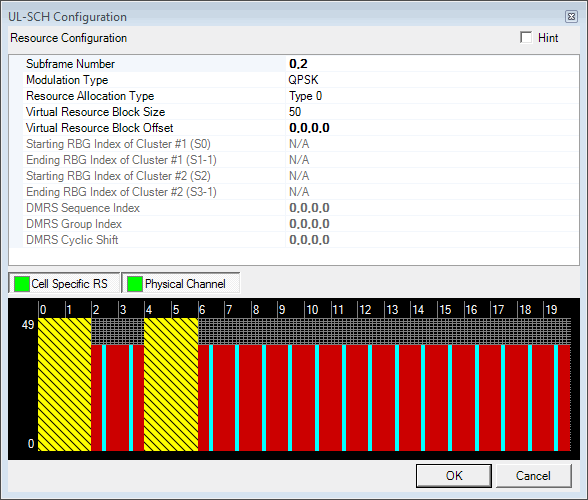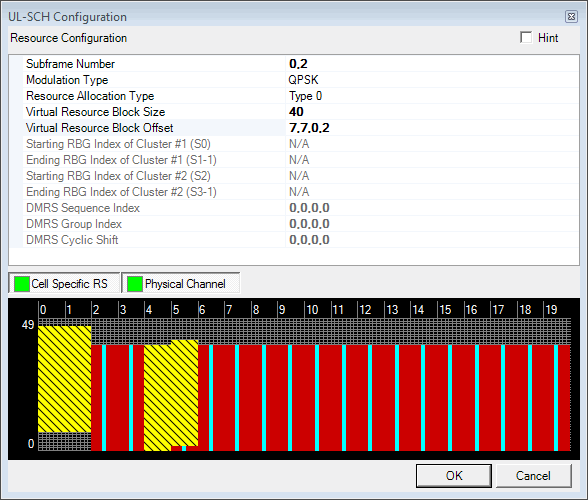 in the Transport Channel node to open the Configure UL-SCH window. The
yellow area with diagonal lines shows the resource blocks occupied by
the currently configured UL-SCH.
in the Transport Channel node to open the Configure UL-SCH window. The
yellow area with diagonal lines shows the resource blocks occupied by
the currently configured UL-SCH. Before adding a transport channel as described below, delete any existing transport channel, physical channel, or resource block collection that occupies the resource blocks that your new transport channel will occupy. If you add a new transport channel without first deleting a conflicting channel or resource block collection, a "code conflicted" error occurs when you generate the waveform.
Click the Add Channel button
 in the Transport Channel node to open the Configure UL-SCH window. The
yellow area with diagonal lines shows the resource blocks occupied by
the currently configured UL-SCH.
in the Transport Channel node to open the Configure UL-SCH window. The
yellow area with diagonal lines shows the resource blocks occupied by
the currently configured UL-SCH.
The number of available resource blocks is determined by the System Bandwidth selection in the Uplink node. Figure 1 shows an UL-SCH with a subframe of 2 added (using Subframe Number) and a Transmission Bandwidth setting of 10 MHz (50RB).
The fields within the Configure UL-SCH window enable you to control the following parameters of the UL-SCH.
Where PUSCH Common parameter Set is set to , DMRS Sequence Index, DMRS Group Index, and DMRS Cyclic Shift will be inactive. Else, they are active.

Figure 1. UL-SCH with subframe 2 added, 50 Resource Blocks, and 0 Offset
Figure 2 shows an UL-SCH in which the Virtual Resource Block Size is set to 40 and the Virtual Resource Block Offset is set to 7 in slot 0 and slot 1.

Figure 2. UL-SCH with 40 Resource Blocks and an Offset of 7
Figure 3 Shows the UL-SCH from Figure 2 with an offset of 0 resource blocks is applied to the third occupied slot (slot 4) and an offset of 2 resource blocks is applied to the fourth occupied slot (slot 5) using the Virtual Resource Block Offset cell.

Figure 3. UL-SCH with different Offsets
|
Resource Configuration |
|---|
Enter the number(s) of the subframe(s) that the UL-SCH will occupy. You can enter the number of a single subframe, two or more subframes separated by commas, or a range of subframes (for example, 1-3)
Choice: QPSK | 16QAM | 64QAM | 256QAM (LTE-A Pro only)
Default: QPSK
Double-click or use the drop-down menu to select a modulation type for the UL-SCH.
Enter a value for the number of virtual resource blocks the UL-SCH channel will occupy. The System Bandwidth defined in the Uplink node determines the range of values for this parameter.
You can apply an offset to each individual slot occupied by the UL-SCH. Enter an integer offset value for each occupied slot, separated by commas. These offsets are applied in order from lowest numbered occupied slot to highest numbered occupied slot.
Range: 1 to 7 (1.4MHz) | 1 to 9 (3MHz) | 1 to 14 (5MHz) | 1 to 18 (10MHz) | 1 to 20 (15MHz) | 1 to 26 (20MHz)
Enter a value of the Starting RBG Index of Cluster #1 (s0) for each subframe respectively, separated by commas (for example, 0,1,0,1...,0,1).
In the case of Resource Allocation Type = Type 1, this parameter is active. Otherwise the Resource Allocation Type parameter is inactive.
There is an input limitation which is s0 < s1 < s2 < s3. For more details, refer to 3GPP TS 36.213.
Range: 1 to 6 (1.4MHz)
1 to 8 (3MHz) | 1 to 13 (5MHz) | 1 to 17 (10MHz) | 1 to 19 (15MHz) | 1 to 25 (20MHz)
Enter a value of the Ending RBG Index of Cluster #1 (s1-1) for each subframe respectively, separated by commas (for example, 0,1,0,1...,0,1).
In the case of Resource Allocation Type = Type 1, this parameter is active. Otherwise the Resource Allocation Type parameter is inactive.
There is an input limitation which is s0 < s1 < s2 < s3. For more details, refer to 3GPP TS 36.213.
Range: 1 to 7 (1.4MHz) | 1 to 9 (3MHz) | 1 to 14 (5MHz) | 1 to 18 (10MHz) | 1 to 20 (15MHz) | 1 to 26 (20MHz)
Enter a value of the Starting RBG Index of Cluster #2 (s2) for each subframe respectively, separated by commas (for example, 0,1,0,1...,0,1).
In the case of Resource Allocation Type = Type 1, this parameter is active. Otherwise the Resource Allocation Type parameter is inactive.
There is an input limitation which is s0 < s1 < s2 < s3. For more details, refer to 3GPP TS 36.213.
Range: 1 to 6 (1.4MHz) | 1 to 8 (3MHz) | 1 to 13 (5MHz) | 1 to 17 (10MHz) | 1 to 19 (15MHz) | 1 to 25 (20MHz)
Enter a value of the Ending RBG Index of Cluster #1 (s3-1) for each subframe respectively, separated by commas (for example, 0,1,0,1...,0,1).
In the case of Resource Allocation Type = Type 1, this parameter is active. Otherwise the Resource Allocation Type parameter is inactive.
There is an input limitation which is s0 < s1 < s2 < s3. For more details, refer to 3GPP TS 36.213.
Range: Depends on Resource Block Size, as follows:
0 (for 1  Resource Block Size
Resource Block Size  5)
5)
0 to 1 (for 6  Resource Block Size
Resource Block Size  maximum Resource Block Size)
maximum Resource Block Size)
Default: 0
Enter a value for the DMRS Sequence Index for each slot, separated by commas.
Range: 0 to 29
Default: 0
Enter a value for the DMRS Group Index for each slot, separated by commas.
Range: 0 to 11
Default: 0
Enter a value for the DMRS Cyclic Shift for each slot, separated by commas.